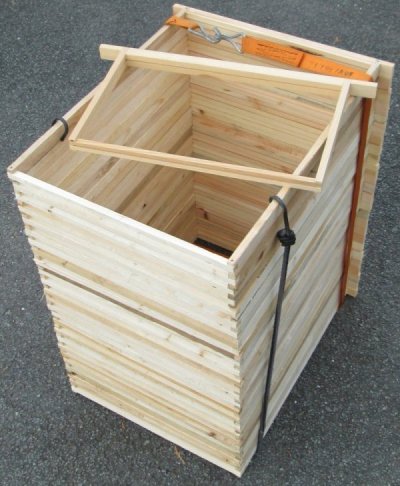 Stack of frames
for the one-box hive with a National deep frame for comparison
Stack of frames
for the one-box hive with a National deep frame for comparisonDavid Heaf's One-box Hive Experiment -- Started April 2014
The idea for this began with a plan to make an Einraumbeute (ERB, one-box hive, sometimes called the 'Golden Hive'*), and buy the frames for it, which are basically Dadant format but with the long sides running vertically. But the shipping cost for the frames from a supplier in Germany was prohibitively high. The attraction of the format is having a brood nest that is not interrupted by top-bars, either top-bars of frames, or, in vertical fixed-comb hives such as the People's Hive (Warré), the top-bars at each box junction. Greater brood nest integrity might be good for colony health.
(* NOTE: a modified version of the golden hive has been developed by Matt Somerville and John Haverson. For photos and details click here. The above was written in March 2014. Since then Matt Somerville has started producing ERB frames. David Heaf started a modified ERB project in January 2015.)
About the time that I was considering the Einraumbeute, I was asked by The Beekeepers Quarterly to review Fedor Lazutin's* book Keeping Bees with a Smile. His hive is like a giant Einraumbeute, and, aside from it using frames and foundation, it and its management have several bee-friendly features to recommend it.
(* NOTE: Sadly, I have to report that Fedor Lazutin died on 16 February 2015, after suffering brain cancer. Leonid Sharashkin, the USA editor of Keeping Bees with a Smile, sent the following communication to those interested in Lazutin's work: http://www.horizontalhive.com/telling-the-bees.shtml)
Frames
Rather than use Lazutin's Dadant-and-a-half sized frames -- a Dadant deep jointed to a Dadant shallow with no intermediate top-bar -- I decided to use the National top-bars that I had to hand, and make long side-bars to approximate to the Lazutin frame format. The result was an 18.5" deep frame with a comb rectangle of 336 mm wide by 440 mm deep. The depth of a National deep comb is 192 mm, so my resulting ultra-deep National width combs are 2.3 times deeper than standard. Einraumbeute combs are 265 mm wide by 425 mm deep, thus my one-box hive combs are about a third bigger than those of the Einraumbeute. (The Einraumbeute (and Dadant) comb format is based on the golden ratio (1.6), hence the English name commonly used for the Einraumbeute.)
The side-bar finger joints were cut with a table saw to make a tight fit in the National top-bars (Thorne's seconds). To improve frame rigidity the joints were given a drop of glue before nailing. Titebond II is recommended for this application.
 Stack of frames
for the one-box hive with a National deep frame for comparison
Stack of frames
for the one-box hive with a National deep frame for comparison
Walls
The wall's of Lazutin's hive are 3" (75 mm) thick. This comprises 6 mm ply inside, 50 mm frame timber and 19 mm weather-board outer cladding. Behind the weather-board is roofing paper. The cavities are filled with polystyrene foam. This wall composition will no doubt help in a Russian winter, but would be somewhat over insulated for UK conditions. The Einraumbeute has 25 mm thick walls in Weymouth pine. Solid wood walls would have been easier to make, but I had access to sufficient ply and framework wood (planed 2" x 1" and 2" x 2") from a plant that crushes municipal waste wood for power station fuel. I made 9 mm ply double walls, using 2" x 1" for the end frames and 2" x 2" for the long side frames. The cavities in the end walls were about 3/4" wide. The cavities were packed with dry reeds standing on end to prevent settlement.
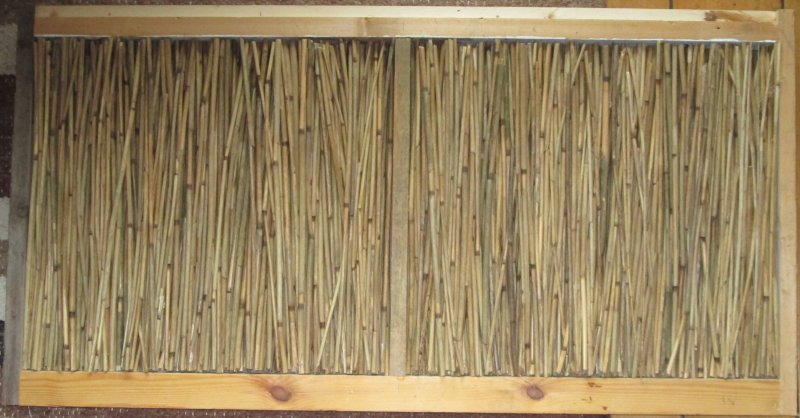
Above: Wall insulation of a long side before covering with 9 mm ply.
The wall panels were assembled using exterior grade glue only. The side walls were rebated along their inner top edges to accommodate the frame lugs (10 mm deep) and National galvanised metal rails (7 mm deep, total 17 mm deep rebate).
Setting bee space
The bee space was set at 8mm using two frames prior to glueing the end walls onto the long sides.
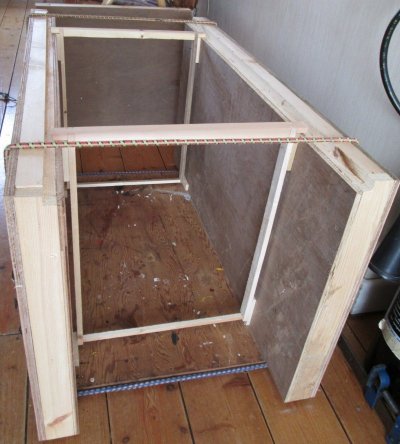
Above: 8 mm thick spacers are inserted in the bee spaces between frames and walls, and the walls secured in position with bungies.
The end walls were glued in place with exterior grade glue and clamped with sash cramps until the following day. Then each end wall was further secured to the ends of the long walls using three 100 mm galvanised screws at each side. After assembly, the metal rails were fitted and aligned to prevent any ridges from hindering free movement of frames.
Exterior wall finish
As the walls are ply, they need a high standard of weather protection to avoid delamination of the ply. Various wall finishes were initially contemplated including the Sadolin exterior wood stain system and acrylic latex paints. However, as they are very expensive in relation to the entire cost of the hive (<£10), and as this is a one-off experiment of possibly short duration, the decision was taken to use old paint already in stock (white wood primer and undercoat) and buy an exterior gloss top coat.
The resulting outer wall finish is not very permeable to water vapour. However, it is expected that the Warré-style quilt (see below) over the whole hive and the ventilated floor will be sufficient for water vapour handling. It is reported that the Einraumbeute is prone to condensation in the winter, so this aspect will be monitored. Lazutin devotes an 8-page chapter to 'Water in the wintering process'. In Russia, colonies are confined for longer periods under very cold conditions and therefore consume a correspondingly greater weight of stores, thus producing more water through the metabolism of honey. Dealing with this water is less of a problem in my milder, windy climate.
Warré quilt
A 95 mm deep quilt tray was made according to the Warré hive design, only with two modifications. A centre strut was added for rigidity and handle recesses were added at the ends for ease of lifting. The recesses were closed on the inside with perforated zinc.
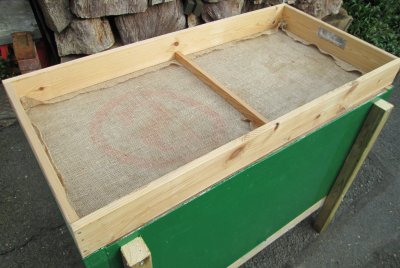
Above: Warré-type quilt; also shows 2" x 2" treated pine legs (zinc plated screwed through to the hive body frame)
Top-bar cloth
The Warré hive has a hessian (jute sacking) top-bar cloth sized with a paste comprising a rye flour and starch mixture. The Einraumbeute has a beeswax impregnated cotton cloth over the top-bars. This is less permeable to moisture than Warré's top-bar cloth. As in the one-box hive being tested here the quilt is being relied on as a main route for water vapour loss, the Warré top-bar cloth was chosen for this application. The cloth was sized in the usual way recommended by Warré using a paste of rye flour with a small amount of starch added. (Top-bar cloth sizing)
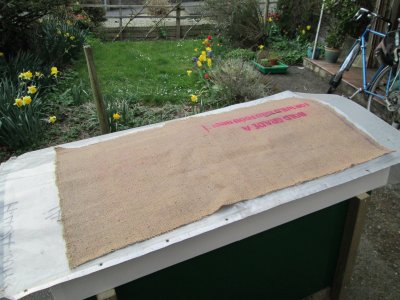 Left: top-bar cloth
drying after sizing
Left: top-bar cloth
drying after sizing
Roof
The roof design is based on the Warré roof only with four modifications: 1. Instead of the three boards on top (one covering the ridge) a sheet of heavy-gauge scrap aluminium was used. This was secured to the gables with stainless steel screws. 2. Ventilation holes were drilled in the gable ends near their apices. 3. Many 3 mm ventilation holes were drilled in the plywood mouse board inside the roof. 4. After initial assembly, when the roof was lifted, the aluminium flexed excessively, so a further rafter support board was added midway between the gable ends.
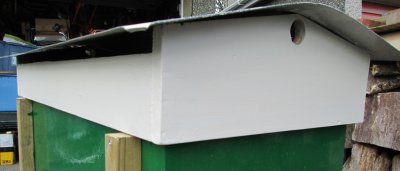 Left: roof before final
paint coat, and before adding additional rafter support
Left: roof before final
paint coat, and before adding additional rafter support
Floor, entrance and alighting board
A removable floor was achieved by fixing two 2" x 1" rails (treated roofing battens) to the legs and sliding inwards on them an untreated board (19 mm), allowing 3 mm clearance. The floor was clamped against the bottom of the hive body by means of a wedge in each corner.
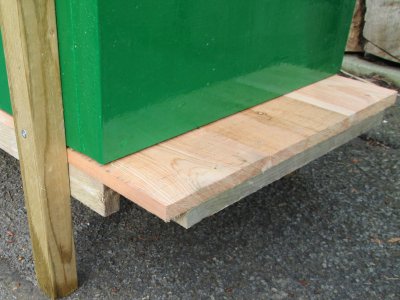
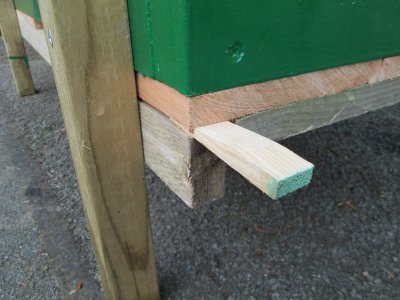
Above left: floor partly slid out on its rails. Above right: wedge between rail and floor board
The entrance was made Warré style by cutting a 120 mm wide notch in the floor board and extending the notch sufficiently far inwards to give a 20 mm by 120 mm aperture inside. The bottom of the notch was closed partly by the floor rail and partly by a short piece of batten nailed to the underside of the floor board.
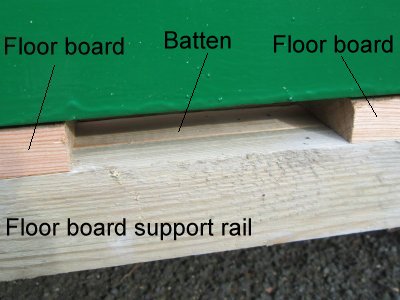
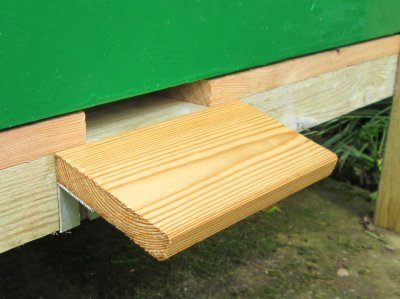
Above left: entrance; above right: removable alighting board secured with aluminium angle and two round-head brass screws
The overall principle of the floor, entrance and alighting board essentially follows that of the Warré hive.
Frame spacers
Plastic Hoffman converter clips from Thornes were used to space the frames at 35 mm centres. See photo below.
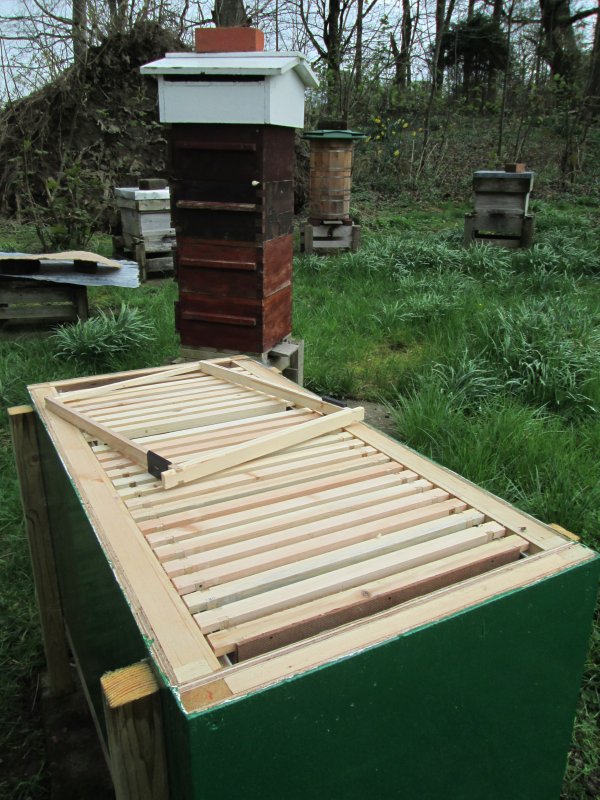
In addition to the inter-frame spacers, Thomas Radetzki suggests adding a frame-to-wall spacer to speed up removal of long frames for inspection without rolling bees. He suggested using nails, but instead I inserted pieces of 3 mm bamboo skewer into 3 mm holes near the bottoms of the side bars, using a blob of glue. These spacers have a 6 mm projection into a bee space of 8 mm.
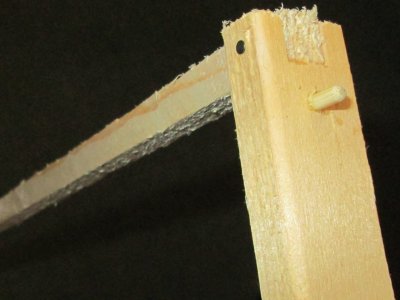 Frame-to-sidewall
spacer
Frame-to-sidewall
spacer
Comb supports
Some consideration was given to the possible need to wire such large combs or insert thin spales in the frames. In the end, following a suggestion kindly given by Andrew Janiak (Melbourne), spale stubs were adopted. These were about 75mm long, 5.5 mm thick, four to each frame and inserted into holes in the frame. As the fit was tight, no glue was used.
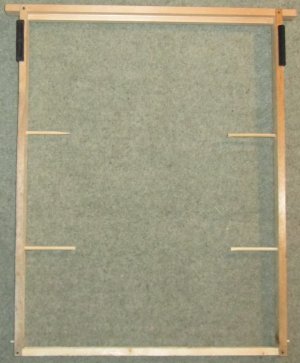
Follower boards and division boards
Two follower boards were made by nailing hardboard to two frames after inserting a sheet of expanded polystyrene (styrofoam) in the inner space. For use as a division board, the 8-mm bee spaces will be closed with foam polyethylene strips.
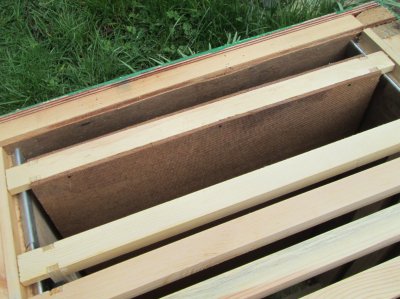 Follower board
Follower board
Two tight-fitting division boards were made with 9mm plywood. Hessian was tacked round the sides and bottom to take up any play between the hive walls/floor and the board. These were particularly useful when hiving so as to prevent the queen entering the cavities to either side of where the nest was started.
Comb guides
The hive will be started with one frame containing a full sheet of National foundation and the adjacent frames containing only foundation starter strips. The foundation is secured in the usual way with the wedge supplied with the National top-bar.
Delivery
This hive is so bulky and heavy that it took two loads of a bike trailer to deliver it to the apiary. Below is a photo of the second load containing roof, quilt, top-bar cloth, floor and frames.
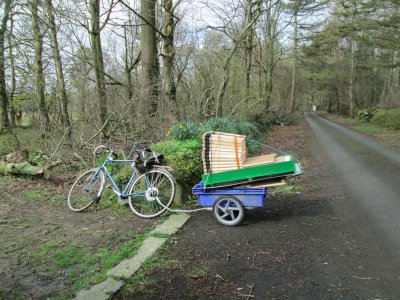
Installation
The hive was placed on a recycled concrete slab once used as the side of a domestic coal bunker. The slab was levelled with a spirit level. With such deep frames, any deviation of the frame from vertical could create problems of comb misalignment. The orientation was south-east thus facing a hive end to the south-west, the direction from which the strongest winds come in this locality. The orientation also exposed mostly one hive end to the direct rays of the hot afternoon sun.
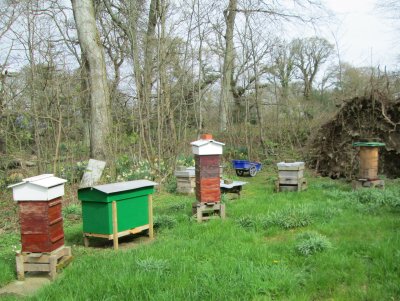
Populating (15 May 2014)
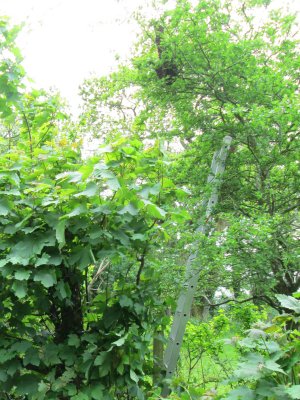
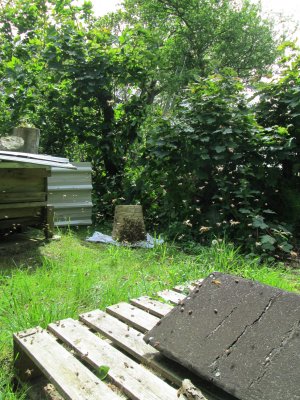
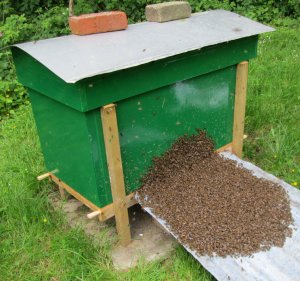
The hive was set up for populating by installing five frames, the middle one having a full sheet of National brood wired foundation and the other four having 20mm starter-strips of foundation only. Two follower boards were added that made a complete seal between the area with frames and the areas either side without.
The hive was populated by running-in a 2.2kg swarm. This was started at about 6.30pm and, and, after checking that running-in was progressing well, was left to carry on. By about 9.45pm the running-in board was clear of bees but about half the volume of the swarm was coating the front of the hive below the rim of the roof. This is a common problem of the running-in method, if the beekeeper cannot be present to occasionally brush down onto the board bees that climb up the hive front. The outside bees were brushed down and within about 30 minutes most had gone into the hive.
By the following morning, there was normal orientation at the hive entrance and pollen was already coming in. A queen excluder (includer) was fitted over the entrance and a feed of honey syrup (2:1 w/w honey:water) was provided in the part with the frames, after moving back the follower board sufficiently. The excluder was removed in the evening as the colony seemed well committed to the hive.
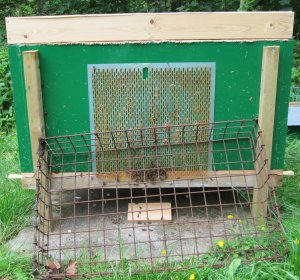 Old queen excluder
propped over entrance
Old queen excluder
propped over entrance
Comb growth
17 May 2014
Two days later (17 May) the middle comb was half built, the ones each side a quarter and the outer ones just started. The weather continued favourable for colony build up. Empty feeders were removed and the sealing division boards were replaced with follower boards that had bee spaces at the bottom and sides.
25 May 2014
Ten days after populating, the middle comb was about 290 mm long and the rest about half built (220-240mm). Capping the first brood was in progress. Honey stores were good enough to see the colony through several days of bad weather. In the photo below, the queen's abdomen is visible in the middle of the comb, about three quarters of the way down.
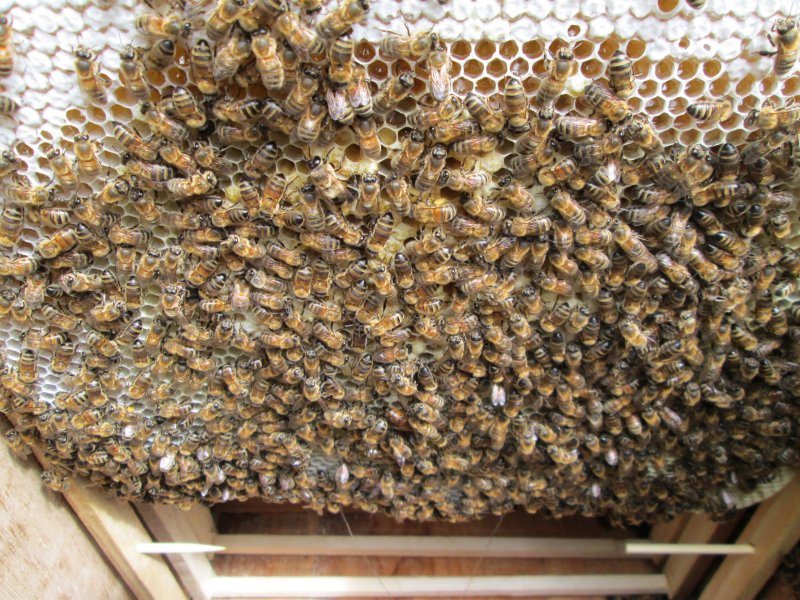
3 June 2014
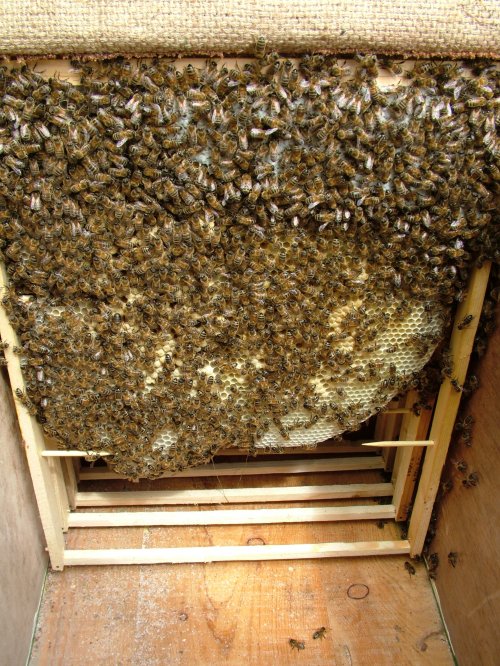
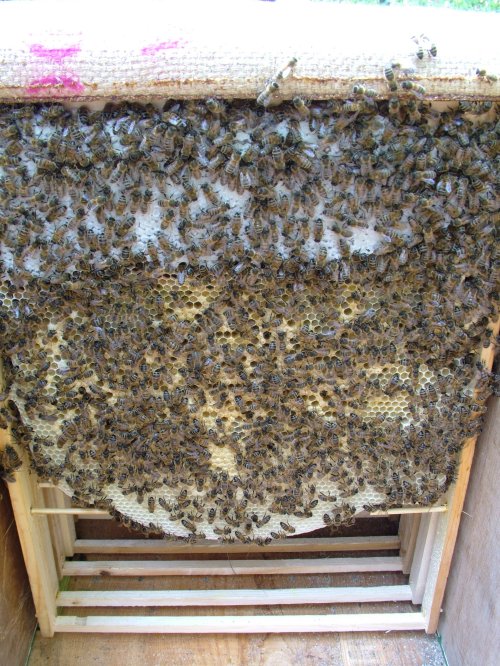
Above left: frame 5, south side. Above right: frame 1, north
side
Below: Closer view of the bottoms of the combs.
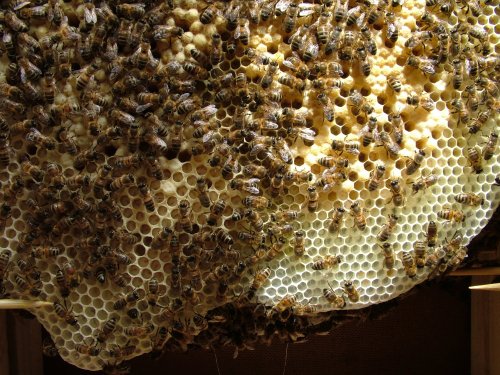
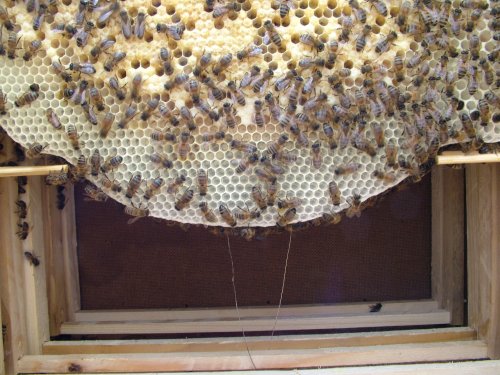
By 19 days the combs extend at their bottom centres a few centimetres below the bottom spale stubs. However there is still approximately 80 mm to go before the comb reaches the bottom bar. The spale stubs interfere with comb growth, but the upper ones are already largely incorporated into the comb. As can be seen from the images, the outer combs have brood on the sides facing the follower boards. Drone brood is evident. Closer inspection of the original photos shows eggs close to the outside of the outer comb margins. Two additional frames with starter strips were given, one each end of the brood nest -- total 7.
29 June 2014
Below left: frame 7, south side (outside face). Below right: frame 1, north side (outside face)
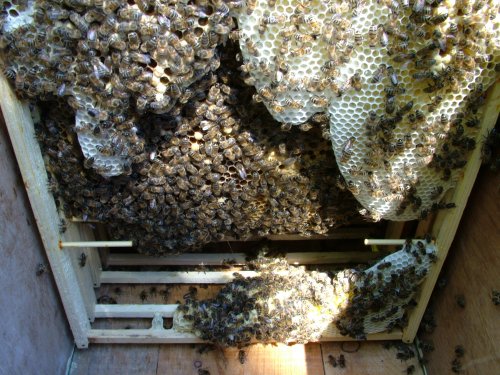
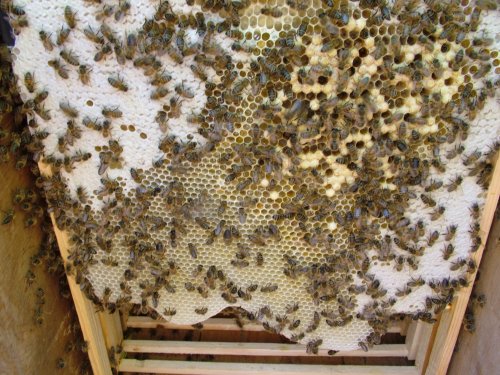
The colony was inspected on 12 June and the new frames (1 & 7) were about a quarter built. A period of hot weather followed. By 29 June the outer comb (frame 7, left photo above) on the south side had collapsed, whereas its counterpart on the opposite side of the nest (right photo above) had developed normally to a little longer than the combs in the rest of the frames. The fallen comb, which contained drone brood and honey, was cut out and the honey part left behind the follower board for the bees to empty. One extra empty frame was given on the north side -- total 8.
Four 75mm spale stubs are clearly insufficient as comb supports. Six 100mm spale stubs would be more secure.
18 July 2014
The colony had apparently swarmed: no brood, far fewer bees and four hatched queen cells.
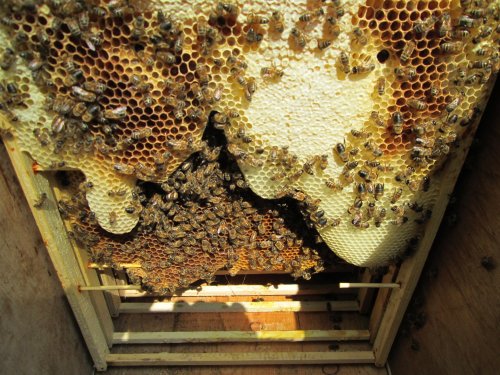 Outside (frame
7), south end
Outside (frame
7), south end
8 August 2014
The colony had requeened itself. Brood of all ages was present both sides of frames 3 and 4. There were sac brood mummies on the floor and at the entrance. The colony has shown spotty brood (empty cells) from the start. At this inspection, there were eggs in the uncapped cells amid the capped brood.
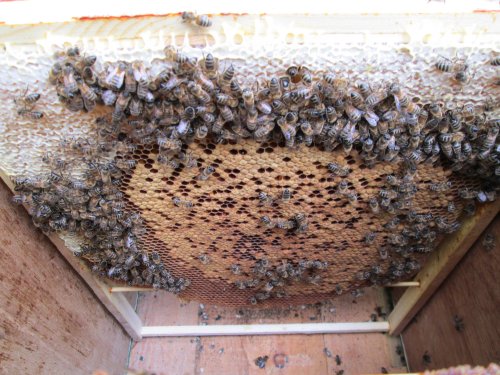 Frame 4, south side
Frame 4, south side
19 September 2014 -- checking prior to winter
As it was considered not practical to heft such a bulky and heavy hive, to assess the stores all frames were inspected on both sides to assess in one eighth increments the area of the frame covered by honey. Four full frame sides or two whole frames of honey were found. Working from the area of Warré honeycombs, which hold 1.5 kg in an area of 600 square centimetres, and given that the area of combs in the one-box hive is 1420 square centimetres, it is calculated that each full comb weighs 3.5kg. Therefore at this point of time, the hive has 7kg honey. As Warré hive stores in this locality are are made up to a minimum of 9kg by the beginning of October, to reach at least that specification a further 2kg feed needs to be given.
16 January 2015
Colony still alive. Bees come out on sunny days with the shade temperature as low as 7C.
15 February 2015
Colony bringing in pollen. Adequate stores on outer frames. No condensation in unoccupied parts of hive.
18-19 March 2015
The floor was modified to move the entrance to one end (small side) in order to create a single honey storage area rather than one at each side. It was also widened to the full width of the inside wall of the end of the box and an entrance block inserted.
Below left: end entrance (120 mm) with removable entrance block. Below right: floor pulled out to show entrance detail.
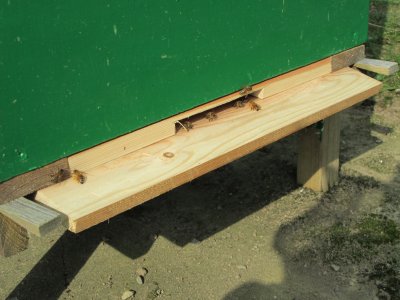
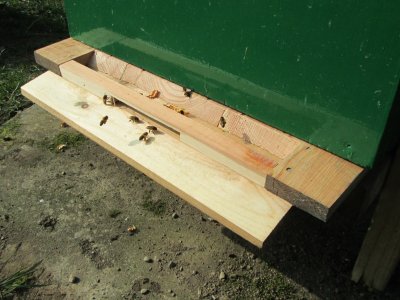
Mostly an unidentified orange pollen was coming in, possibly crocus. The combs were moved to the entrance end, retaining their original order, including a follower board at the entrance end. Comb 5 has a hand sized patch of brood both sides and comb 6 has a palm sized patch both sides. The estimated total honey remaining after the winter from the 9 kg estimated in September was 5.25 kg, indicating that 3.75 kg of it was consumed. However, the total winter consumption may be underestimated because the ivy flow in October would have contributed something. The average comb length still fills only about two thirds of the frame depth.
8 April 2015
Now the bees are used to the new position of the entrance, the brood nest was moved from the middle to the end with the entrance, keeping a follower board a bee space away from the wall with the entrance. In making the move, frames 4 (pollen), 5 & 6 (brood) and 7 (pollen) became frames 1-4 counting from the entrance. Most of the honey was on frames 2 & 3 and these became frames 5 & 6 in the new configuration. Frame 7 was empty, frame 8 (formerly frame 1) was one third drawn. Frame 9 was empty.
11 May 2015
Comb 9 now a quarter built. Combs 8 & 7, a little over half built, have drone brood both sides. Comb 6 has worker brood on the side facing away from the entrance. Assuming an uninterrupted brood nest, it has gone from 2 to 7 frames of brood since 8 April 2015.
17 May 2015
It has been a cooler than average May, but comb 9 (see image below) is now about half built, also combs 8 & 7 are well developed. An additional empty frame (Frame 10) was added, this time with 100mm comb supports. Mould was noticed on the top-bar cloth and one wall (north) in the unoccupied part of the hive. A few chalk brood mummies are on the floor.
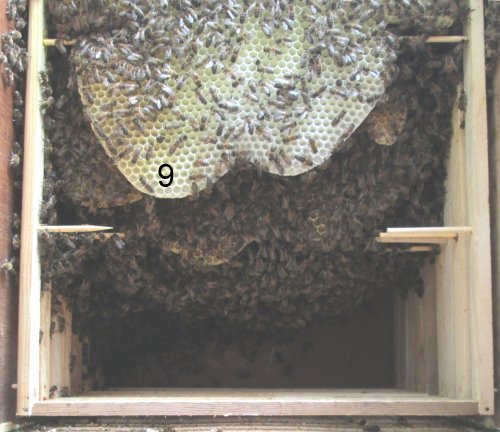
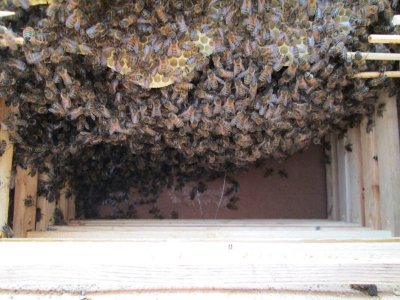
4 June 2015
Frame 10 is 1/3 drawn. Frame 11 was added. May was a cold, wet
month averaging about 3 degrees C below the average here for the month. This has delayed
the onset of swarming. Its median start date is 16 May but this year it started today (4
June).
20 June 2015
F11 2/3 built. Gave F12.
3 July 2015
F12 1/2 built. F13 & 14 given.
19 July 2015
F14 1/3 built. F15 given.
25 July 2015
F15 -- building started. F14 half built.
8 September 2015
Estimated stores weights by inspection as above. Most had a narrow
band of honey at the top totalling about 4.5 kg. Fed 5 kg sugar as 2:1 syrup. Moved F13
& F14 to positions 1 & 2 in order to allow space for new comb in the brood nest
near the entrance and gradually work old comb out of the brood nest.
22 October 2015
Ivy pollen coming in. Mouse guard fitted.
22 January 2016
Unseasonally warm sunny day: many bees flying.
12 April 2016
Patches of brood on F5 & 6. The pollen layer was inside F4. There is plenty of space near the entrance for brood to spread onto newer comb. Most of the frames towards the back had several centimetres of stores left after winter.
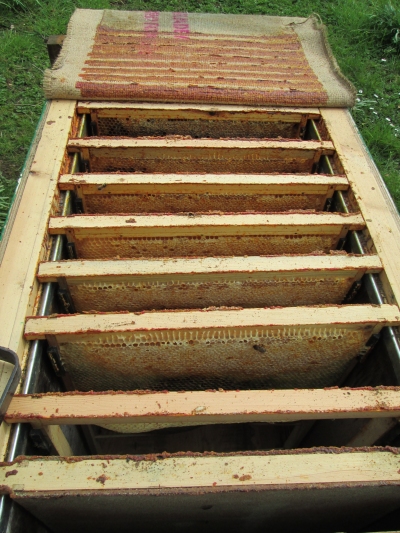
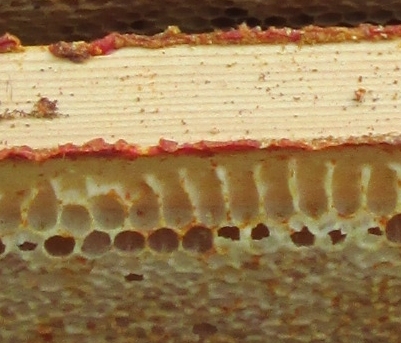
The bees tend to push propolis into the gap between the top-bars and the top-bar cloth, thus lifting the top and creating a channel. Wax moth larvae are occasionally found in this channel. It seems that the quilt filling needs to be heavier to minimise this effect. The same phenomenon occurs on Warré hives.
14 May 2016
Removed follower board by entrance and inserted a frame from the back with some comb on it. Brood was on frames 5-8 and on the front side of F9.
28 & 30 May 2016
Brood now on the rear of frame 13 and pollen on the front side of frame 14. Brood nest has expanded from the front of F9 to the rear of F13 in a fortnight. Frame 15 heavy with honey. Inserted a new frame with a starter strip either side of frame 15.
9,16 & 22 June 2016
Rearmost comb (F16) now part drawn. Gave F18 with starter strip next to follower board. Not building on it by 22nd.
3 July 2016
The colony built up slowly this year but by this inspection was foraging intensely.
12 July 2016
Large numbers of bees behind the follower board. Brood now on F 14.
20 September 2016
| Frame | Comb area | Contents | Frame | Comb area | Contents |
| 18 | started | empty | 9 | 7/8 | capped brood, no eggs |
| 17 | 1/4 | empty | 8 | 7/8 | capped brood, no eggs |
| 16 | 1/2 | empty | 7 | 7/8 | nectar/pollen |
| 15 | 2/3 | empty | 6 | 7/8 | lots of brood & eggs |
| 14 | 2/3 | empty | 5 | 7/8 | lots of brood & eggs |
| 13 | 3/4 | empty | 4 | 7/8 | lots of brood & eggs |
| 12 | 3/4 | trace nectar/pollen | 3 | 1/2 | empty |
| 11 | 3/4 | trace nectar/pollen | 2 | 1/2 | empty |
| 10 | 7/8 | nectar/pollen | 1 | 1/8 | empty |
Summary: populous, calm, brood on 5 frames but no capped stores. Nectar or uncapped honey was scattered here and there throughout the nest.
4 October 2016
Frames 5 and 6 had lots of brood and were heavy. Frames 4, 7, 8 & 9 have some capped and uncapped honey. Some nectar on F10-12. Estimated about 2 combs of honey, i.e. about 7 kg. Made up to 9 kg with a 2 kg feed. A particularly intense ivy flow this month helped supplement the winter stores.
25 February 2017
The bees have been flying in recent weeks, bringing in pollen mainly from Galanthus nivalis.
A 6-sensor hive temperature monitor was installed in this hive and began recording on 27 February 2017. Full details here.
Spring/summer 2017
This colony continued to forage vigorously throughout the period. There was evidence from the temperature sensors that in July in seams 5/6 and 7/8 the brood nest either contracted or the queen went off lay. But both seams were back to brood temperature by mid-August.
8 September 2017
Estimated stores to be almost two full frames, i.e. about 7 kg, scattered as before across most frames of the nest.
10 October 2017
As stores were below the 9 kg estimated as necessary for this locality, a feed of 2 kg sugar as syrup with 50 g honey was given.
25 April 2018
Cessation of temperature monitoring.
Spring/summer 2018
Flight traffic was vigorous through a spring and early summer with the many weeks of exceptionally warm weather. The entrance block was removed throughout the hot spell. Due to illness, no interventions in the interior of the hive were made during this period.
24 August 2018
With the help of visitors Lynn Roberts and Emma Vowles the rearmost 10 frames were inspected and photographed. They were all heavy with honey. Brood nest frames were viewed with the help of Lynn Roberts' rotateable holder for frames. Drone brood in worker cells was present on frame 10 counting from the front. Queen-laid eggs were seen on frame 9 from the front (but see below). There were still lots of drones present despite the lateness in the season. The photos below show the liberal propolisation of the top-bar cloth between the top-bars. Inspection was stopped at frame 9 as the weather was not ideal and the bees were becoming agitated. A further inspection of the brood nest is warranted to check for queen failure (drone layer).
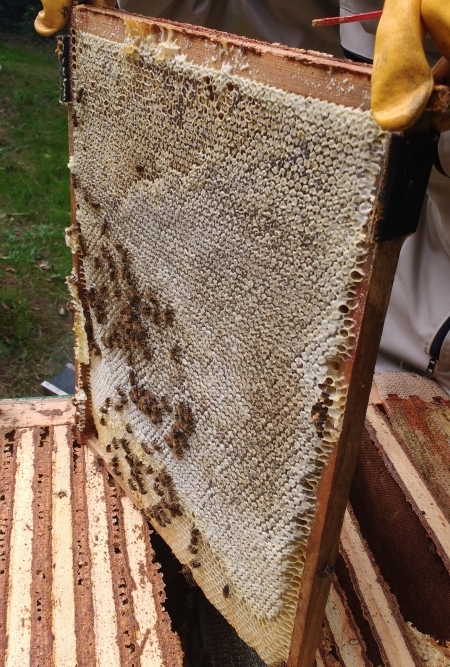
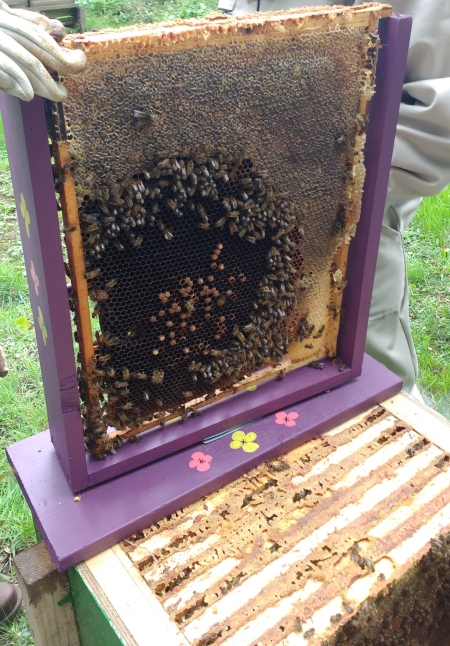
Above left: frame 3 from the back Above right: frame 9 from the back on Lynn Roberts' frame holder
17 September 2018
Six frames from the rear of the hive were harvested into a purpose built harvesting box. The gross weight was 31.5 kg. The heaviest frame of comb weighed 5.2 kg. The honey in the harvested frames was exceptionally dry. Honey mixed from three cells on the heaviest comb read 13.5% moisture on a refractometer whose Brix calibration had been checked with olive oil.
The colony was extremely defensive, did not respond to smoke and bees tried hard to get inside the protective clothing. It was also noticed that in recent days there was hardly any pollen going in and a group of a dozen or so bees were gathered on the alighting board apparently doing nothing. They were quick to fly at any disturbance. These symptoms, taken with the results of inspection on 24 August, suggest a hopelessly queenless colony.
As, on the day of harvesting, weather conditions were far from ideal for disturbing a defensive colony, better weather is awaited during which to carry out a full inspection, and, if necessary, remove the remaining bees from the hive and close it up against robbers.
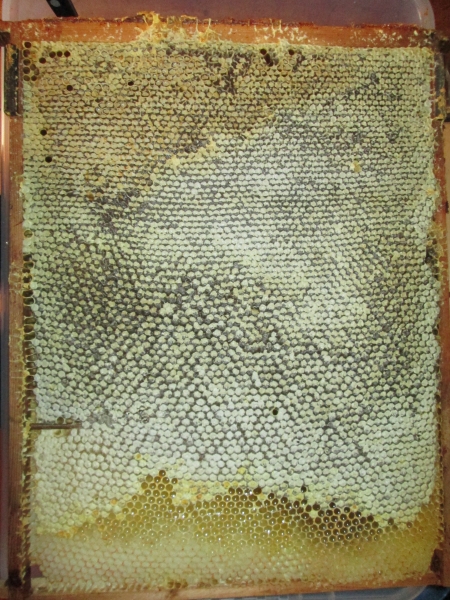 A 5.2 kg frame.
A 5.2 kg frame.
The frames were placed over a 45 litre clear polypropylene box and the comb sliced into the box.
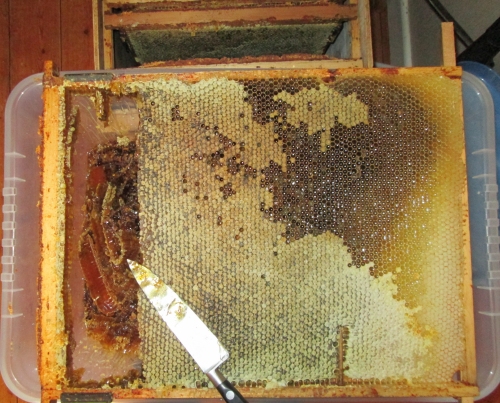 Cutting out
comb.
Cutting out
comb.
Slices of comb were cut up more in the box and the honey separated from the comb by straining. Photos of the straining setup are shown on this page. The final yield was 21 kg (46 lb) honey. Much more honey was left on the hive than needed even in a severe winter. Wet frames were returned to the hive for cleaning by the bees.
April 2019
There was forager traffic on 31 March 2019, but very little pollen coming in. A full inspection was done on 10 April but no queen could be found and there was no brood of any kind. The colony had lived nearly four years, treatment free. The remaining 16 kg of honey was harvested and the hive cleaned out. There was some disintegration of the outer wall on the south-west side, apparently due to interstitial condensation. The damage on the opposite side was less severe. The long walls were repaired by inserting a kitchen foil vapour barrier on the outside of the inner leaf, followed by a layer of 25 mm polystyrene, and the rest of the volume made up by the existing reeds. The outer leaf was repaired with 6 mm marine plywood.
20 April 2019
An early prime swarm that came to a bait hive in the same apiary allowed this hive to be repopulated. A single sheet of National shallow foundation was used in a central frame as a guide. The remaining frames had a few millimetres of comb from the previous colony. The swarm was fed with 2 kg honey.
28 April 2019
Inspection showed that the bees were building straight comb on frames 1-8 and worker brood was present on frames 5, 6 and 7. The queen, with obvious ligustica colouration was on frame 5.
1 August 2019
George Hawkins, Salford University, sampled comb for recapping analysis.
6 April 2020
Colony hived previous April survived winter, but not very vigorous.
16 April 2020
Plenty of pollen coming in
16 May 2020
Brod at all stages on frame 5. 8 frames between F5 and division board.
11 July 2020
Bees on rearmost comb by follower board. Added an extra frame.
3 September 2020
Colony somewhat slack over summerr. Harvested 5 frames with honey. Populous but lots of drones still. Some capped worker brood hatching. Drone brood in worker comb. No evidence of laying workers. Bees agitated. Recent nectar deposited.
6 September 2020
Thinking the colony was failing, began harvesting remaining honey. Bees very defensive. Shook bees in front of hive. Found queen laid eggs on F3. Possible recent supersedure. Reassembled . Bees at front of hive re-entered.
21 September 2020
Lots pollen coming in. Gave 2kg syrup winter feed supplement.
28 January 2021
9 degrees Celsius. Colony responded to light knock on hive wall.
3 April 2021
Inspection: brood at all stages but some drone cells amongst it indicating a failing queen. In subsequent weeks, not much traffic but always some pollen coming in.
11 June 2021
Inspection: drone cells only, very few bees, queen failure, bees shaken out in apiary, honey harvested and combs rendered.
20 June 2021
Lots of scouts at entrance late on 19 June and early on 20th. A swarm moved in during the morning.
11 July 2021
Inspection of combs revealed absence of eggs. The incoming swarm arrived 3 weeks ago so even if it contained a virgin queen, she has had plenty of time to start laying. Queen failure was therefore assumed and as the colony was somewhat small, a swarm was sought to requeen the colony and increase its population.
13 July 2021
Still no sign of eggs. A 1.1 kg swarm was united with the colony over newspaper. There was no fighting, further confirming that the hive was queenless.
16 & 21 July 2021
Foraging vigorously, pollen coming in.
24 August 2021
As forager traffic seemed abnormally low in recent weeks the colony was inspected. It was acceptably populous but very defencive. There was new comb and recently stored honey. Hatched queen cells were found on frame 6 and a palm sized patch of brood on frame 3. It seems probable that the colony had recently replaced its queen.
29 September 2021
Foraging well with ivy pollen coming in. As the weather had cooled down considerably and there for not ideal conditions for inspecting all the frames to assess winter stores, the decision was taken to give a precautionary feed. As honey was left from the previous colony and the ivy flow was in progress, the pre-winter feed was limited to 2 kg sugar as 2:1 syrup.
4 October 2021
Fitted mouse guard. Foraging well.
21 March 2022
Mouse guard removed. First willow pollen loads seen on 15 March.
10 April 2022
Building up slowly. Nest extending to frame 6 from the front (entrance). Frames given at back of nest for nest expansion.
5 May 2022
Installed Termio 2 temperature monitor and datalogger with probe inserted in brood the nest. Inserted a card under the frames with the intention of collecting mites for a research project at the University of South Bohemia. Temperature shown on Termio 2 on 14 May was 35.22ºC, and on 24 May 35.44ºC. As nothing was collected on the cardboard insert by 24 May it was removed and temperature monitoring stopped.
11 July 2022
Nest had expanded greatly and cross-comb was being built against the follower board. While trying to cut it off it fell to the floor and later some honey leaked out through a crack in the floor, fortunately with no robbing consequences. Added three more empty frames.
21 September 2022
Mouse guard fitted.
24 Sptember 2022
Harvesting: Six honey frames were harvested. Due to cross-comb, three were lifted out as single unit. Removing bees from these by smoking and brushing with a bird's wing proved slow and laborious. Harvesting when the bees are clustering in cooler weather would probably have yielded bee-free combs. The follower board was moved up to the rearmost frame of the now reduced nest.The frames of honeycomb were transferred to a harvesting box. The yield was 19.7 kg honey and comb from which 16.6 kg honey was extracted.
References
1. Lazutin, Fedor (2013) Keeping Bees with a Smile. Deep Snow Press. ISBN 978-0-9842873-5-2. www.deepsnowpress.com/keeping-bees-with-a-smile.htm
2. Warré, Émile (1948) Beekeeping for All, 12th edition. Saint-Symphorien http://warre.biobees.com
3. Uwe Bodenschatz's website on the Einraumbeute www.bodenschatz.de
4. Mellifera e.V. page on the Einraumbeute: http://www.mellifera.de/einraumbeute/ . The hive was developed by a group at Mellifera, Fischermühle, Germany. Several documents and a video are accessible on this mellifera.de page.
See also:
Lynn Roberts' (Anglesey, N Wales) modified Lazutin hive here
David Marshall's (N. Wales) modified Lazutin hive here
Emily Reed's modified Lazutin hive here (video)
Barbara Westfall's (Ontario) deep-frame horizontal hive here
David Heaf's modified Einraumbeute here
Pages in Russian about Fedor Lazutin and his ecovillage initiative
https://www.ladenya.ru/ecobee/lazutin
http://www.eco-kovcheg.ru/fedor.html
Russian Translator: https://translate.yandex.ru/
Contact: david (at) dheaf (dot) plus (dot) com